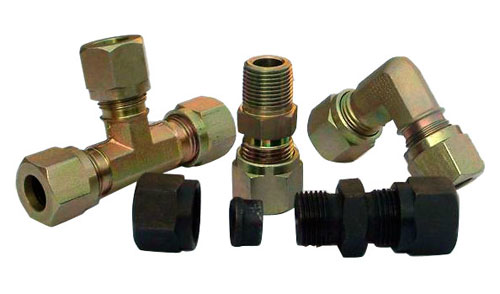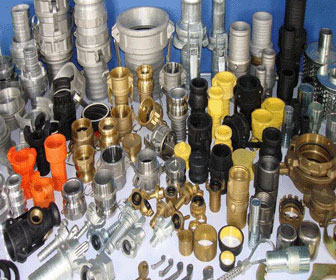Engineers looking to specify hose couplings need to consider a few things besides correct size. Will the couplings be reused or permanent? Will it need a locking mechanism to prevent involuntary disconnection? Is one-handed operation required?
Couplings can be two types: permanent and reusable, or field-attachable. Permanent couplings are generally more reliable, easier, and quicker to attach than field-attachable couplings, which makes them widely used in industry.
Crimping or swaging equipment (sometimes both) is needed to put a permanent coupling on a hose. Permanent couplings can be pre-assembled, (one piece), with a ferrule permanently attached to the stem.
Higher-pressure hoses use field-attachable (also called reusable) couplings, as well as permanent couplings. Field-attachable couplings fit right on the hose using only a wrench and a vise. No special equipment is required. While handy, they do cost more than permanent couplings and take more time to attach.
There are three common types of coupling interfaces used in hydraulics today: thread interface, mated angle, and O-ring.
Threaded couplings have two types of threads: male (outside threads) and female (inside threads). The National Pipe Tapered for Fuel (NPTF) has, as the name implies, a tapered thread. When the male and female components are threaded together, the tapered threads deform, applying pressure on one another, and thus making a tight seal.
Mated angle couplings form a seal when the male and female threads are screwed together. Two types of mated angle seals are SAE 45° and JIC 37°, but there are others. The NPSM seal is a mated angle.
Couplings with angle seats for sealing have straight or parallel threads. The threads themselves do not seal fluids as with tapered threads. Instead, the threads function to mechanically bring the two mating angle seats together.
National Pipe Straight Thread Mechanical Joint (NPSM) brings two 30° tapered seats together to make the seal. SAE 45° flare couplings are used on lower pressure applications, such as fuel lines, hot oil lines or refrigerant lines. JIC 37° angle seats are used on medium-pressure and high-pressure lines on heavy equipment to join hydraulic hose assemblies to hydraulic system components.
There are three types of O-ring seal designs: O-ring boss, flat-face O-ring seal, and O-ring flange. In the boss design, straight threads make the connection while a rubber O-ring makes the seal. Threads pull the O-ring against the port, which has a machined groove for the O-ring, flattening it and making a seal that is excellent for high-pressure applications.
In a flat-face O-ring seal, the O-ring sits in a groove on the male’s face. The seal is made when the O-ring of the male meets the flat face of the female. The solid male O-ring face seal fitting will mate only with a swivel female O-ring face seal fitting.
O-ring flanges make high-pressure, large-diameter connections. A port is bored with a center outlet, surrounded by a smooth flat face which has four tapped holes and four mounting bolts that tighten down onto flange clamps. There are no threads on this coupling. The flange itself has the groove for the O-ring.
There are a number of SAE standards that cover the performance requirements of hydraulic hose assemblies. Included are the J517, J516, and J343 standards.
Hydraulic hoses that are claimed to meet SAE J517 standards (e.g. SAE 100R1 and SAE 100R2) need to be designed for, and certified to, the criteria defined by SAE. That criteria includes stringent dimensional tolerances (inside, outside, and braid diameters), compound and reinforcement types, length changes, cold flexibility, and ozone and heat resistance. There are also burst pressure and impulse requirements in J517. Those requirements are for coupled assemblies, and SAE states that “the general and dimensional standards for hydraulic hose fittings are obtained in SAE J526.”
Hydraulic hose fittings that meet SAE J516 standards are similarly well defined by SAE as to material type, dimensions, finish, etc. The SAE manual also specifically states that J516 fittings are intended to be used “in conjunction with hydraulic hoses specified in SAE J517, and used in hydraulic systems on mobile and stationary equipment.”
SAE J343 is the standard that establishes “uniform methods of the testing and performance evaluation of the SAE 100R series of hydraulic hose and hose assemblies.” Coupled assemblies are expected to meet or exceed SAE performance if the SAE criteria described above are met.
The integrity of any hose assembly depends upon the components, fittings, and hose meeting the rigorous SAE requirements, and then the components being assembled by skilled personnel. This is true regardless of where the components are manufactured.
What do you need to know to specify hydraulic couplings?
- Hose size
- Seat angle
- Type of seat (inverted, flat)
- Thread pitch
- Maximum temperature
- Maximum pressure
- Hose material




Good Article, thanks for sharing! 😉
Nice article on buying a hose coupling. I think along with all these factors we must consider the reliability and popularity of manufacturer to get the right product.